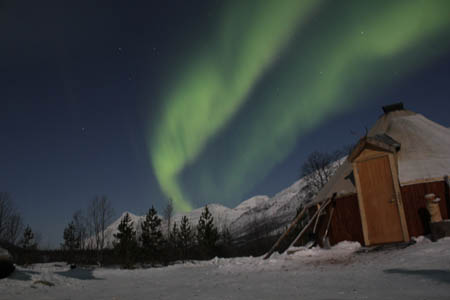An aurora image taken over Muonio, Finland, before sunrise on 27 February 2012. Photo by Thomas Kast. Image courtesy of NASA
It was an active solar weekend, as NASA has confirmed that the sun produced five solar eruptions, producing coronal mass ejections in the Earth’s direction. The result was that those in high latitudes were treated to some stunning auroras, especially on Sunday.
So why has the sun been producing more solar eruptions of late? Solar activity amplifies every 11 years, and the sun is entering the peak of this cycle, also known as a solar maximum. According to the National Oceanic and Atmospheric Administration (NOAA), the next solar maximum is expected to happen in May 2013.
Such increased solar activity means that solar flares and coronal mass ejections (CMEs) look set to be more prevalent this year, sometimes causing solar storms. Solar activity triggers solar flares that then hurl their radiation towards Earth. However, such solar activity does not pose a threat to the Earth’s surface because the magnetosphere and atmosphere both deflect and absorb the solar energy and particles.
Telecommunications
Geomagnetic storms can also pose a threat to astronauts in space, plus they can also affect telecommunications, power grids, radio signals and GPS systems. That is why telcos and utilities are keeping a close eye on the sun’s activity this year.
CMEs themselves are bursts of solar wind that spark auroras, similar to what you see when you visualise the Northern Lights in northern latitudes, such as Norway.

NASA said the sun produced five eruptions over a two-day period this past weekend. The fourth eruption hurled white-hot material (circular inset) high into the solar corona. Image by NASA/SOHO/H. Zell
NASA said a CME hit the Earth’s magnetic field on 26 February (Sunday). And while it said the CME’s impact was weak, it did spark some auroras around the Arctic Circle at 4pm EST (9pm UT). The space agency said the CME does not appear set to cause a strong geomagnetic storm this week.
Geomagnetic storms
Back on 23 January, NASA reported the strongest solar radiation storm since September 2005. This was due to an eruption on the sun on 22 January. It resulted in a CME that hit the Earth’s magnetic field around 24 January. And the impact? A G1-class geomagnetic storm that produced bright auroras around the Arctic Circle. It meant flight carriers such as Delta had to reroute their flight paths around the North Pole as a precautionary measure.
Aurora borealis in action
Here’s an image of the aurora borealis, captured in Norway a few weeks ago:

Image by Adam Renardson